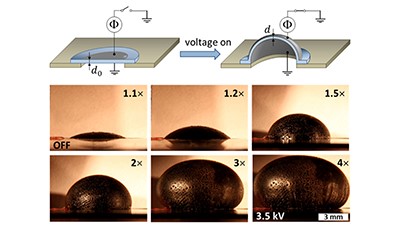Were you looking for that perfect gift for that special someone this holiday season?
How about a new electroactive polymer material that can change shape and size when exposed to a small electric field?
The “bottlebrush” silicone elastomer,
developed by a multi-institutional research team, opens the door to a suite of device applications ranging from microrobotics to designer haptic, optic, microfluidic, and wearable technologies.
BOTTLEBRUSH ELASTOMERS ENABLE ACTUATION AT LOW ELECTRIC FIELDS
The engineering feat conquers two longstanding obstacles that have hindered the use of electroactive polymers in developing new devices. In terms of achievable strains, dielectric elastomers are the most responsive electroactive polymers. But their adoption by the smart materials community for use in commercial devices has been slowed for two reasons
Traditional dielectric elastomers required large electric fields in order to trigger actuation, or movement, at least 100 kilovolts per millimeter (kV/mm). The new material allows actuation at levels as low as ca. 10 kV/mm, according to Richard J. Spontak, professor of materials science and engineering at NC State.
"First, previous dielectric elastomers required large electric fields in order to trigger actuation, or movement—on the order of at least 100 kilovolts per millimeter (kV/mm). With our new material, we can see actuation at levels as low as ca. 10 kV/mm," Spontak explains. "The second challenge is that, previously, materials had to be pre-strained. This would either mean using a frame to physically strain the material, or adding a second component to the polymer to retain the strain after it was applied."
The material consists of a single component that is specifically designed at the molecular level to inherently possess pre-strain. In other words, Spontak says, a frame or a second component isn't needed because the material is ready for use after being cross-linked into a specific shape.
Bottlebrush polymers are prepared by grafting long polymeric side chains to a polymer backbone, according to Sergei S. Sheiko, a UNC chemistry professor and corresponding author of the paper.
"The resulting molecules may be viewed as filaments that are thick, yet remain quite flexible, which allows for significant reduction of the materials’ rigidity and makes them more stretchable," he says.
The mechanical properties can be controlled by varying the bottlebrush architecture. "For example, preparing molecules with different degrees of polymerization of grafted chains and different grafting densities," Sheiko adds.
“This architectural control of mechanical properties has reduced the limit of stiffness in dry polymer materials by 1,000 times, demonstrated extensibility of up to eight times, and opened up new applications not available to stiffer materials or materials with liquid fractions,” Sheiko notes. “One of these applications—their use as free-standing dielectric elastomers—has been demonstrated."
“We’re at the earliest stages of identifying all the potential ways in which we could use this new class of material,” Spontak says. “It works better than anticipated, and now we’re beginning to consider potential applications.”
The research team, comprising members from North Carolina State University, the University of North Carolina at Chapel Hill, Carnegie Mellon University, and the University of Akron, published their
findings in
Advanced Materials.
Electrical response of a circular diaphragm composed of a pure bottlebrush elastomer upon electroactuation with increasing voltage and without any external pre-strain. The numbers indicate the electric field-induced area expansion under constant-volume conditions at room temperature.




